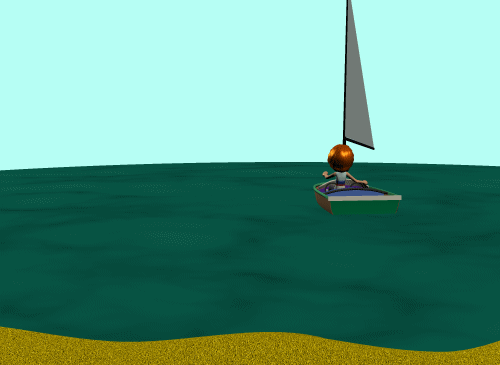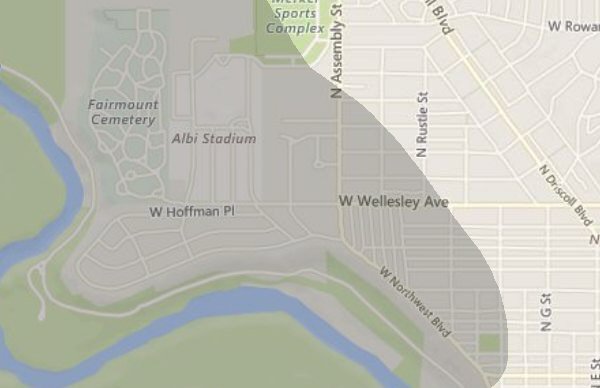Friday, November 24, 2017
One "theory" that won't be proved true
In a time when so many of the classic "conspiracy theories" are turning out to be not only true but wildly understated, it's sort of refreshing to find one that won't be verified.
The dude who is trying to prove the earth is flat won't succeed.
The ONLY standard for any idea or thought is direct experience. You can't trust any expert. All experts are paid to be wrong.
On the flat-earth question you don't need experts or math. You can check it out for yourself.
The flat-earthers seem to think that horizon effects are due to fading in the atmosphere. They're missing one crucial distinction.
= = = = =
You can see fading best in dense fog.
 Fog creates a vertical horizon. Long objects like Polistra's interurban car can be seen passing through the 'curtain' from front to back. On a static object like a large building, you can see where the curtain falls. (I'm not sure why the curtain is so sharp; I suspect it has to do with the inverse-square relationship of light intensity. The curtain is the inflection point of the parabolic curve.)
= = = = =
When an object is moving on a large lake or ocean, the curtain is horizontal. As the object moves away from you, the object disappears from bottom to top. This indicates a curved surface. You can see the same sequence by moving things around on a small curved surface like a globe or a hat or a teapot, where fading couldn't possibly be an issue.
Fog creates a vertical horizon. Long objects like Polistra's interurban car can be seen passing through the 'curtain' from front to back. On a static object like a large building, you can see where the curtain falls. (I'm not sure why the curtain is so sharp; I suspect it has to do with the inverse-square relationship of light intensity. The curtain is the inflection point of the parabolic curve.)
= = = = =
When an object is moving on a large lake or ocean, the curtain is horizontal. As the object moves away from you, the object disappears from bottom to top. This indicates a curved surface. You can see the same sequence by moving things around on a small curved surface like a globe or a hat or a teapot, where fading couldn't possibly be an issue.
 There's no way fog or dust or smog can make the bottom of an object disappear before the top. You can see this nicely on a line of tall trees. In front of the fog curtain, each tree is equally visible from top to bottom; the trees behind the curtain are equally faint from top to bottom.
= = = = =
Generally the flat-earthers also claim that NASA faked the moon landings. This is a completely separate claim, and could well be true. Here we're discussing the activities of USA STRONG and Deepstate, not a basic property of Nature. So far every single activity of Deepstate since 1945 has turned out to be infinitely infinitely infinitely infinitely evil and unimaginably false beyond false beyond false. Why should this one be different?
= = = = =
Later: When the fog itself is 'banked', the edge of the fog is obviously a curtain. How does the intensity-based curtain vary as you enter and leave the real edge? I got a chance to test it this morning. This neighborhood is fairly close to the river, so the west part of the area tends to get 'banked' fog......
There's no way fog or dust or smog can make the bottom of an object disappear before the top. You can see this nicely on a line of tall trees. In front of the fog curtain, each tree is equally visible from top to bottom; the trees behind the curtain are equally faint from top to bottom.
= = = = =
Generally the flat-earthers also claim that NASA faked the moon landings. This is a completely separate claim, and could well be true. Here we're discussing the activities of USA STRONG and Deepstate, not a basic property of Nature. So far every single activity of Deepstate since 1945 has turned out to be infinitely infinitely infinitely infinitely evil and unimaginably false beyond false beyond false. Why should this one be different?
= = = = =
Later: When the fog itself is 'banked', the edge of the fog is obviously a curtain. How does the intensity-based curtain vary as you enter and leave the real edge? I got a chance to test it this morning. This neighborhood is fairly close to the river, so the west part of the area tends to get 'banked' fog......
 This morning my house (at east end) was in the clear, and the fog started about 4 blocks west of me. Approaching the bank, there was clearly a curtain that didn't need any fancy explanations. After I got inside the bank, I focused on the curtain, which was then the intensity-based horizon. The curtain moved with me, remaining about 100 feet ahead. When I turned around and walked eastward, the curtain moved but got less sharp as I walked out of the bank, then finally disappeared near my house.
This morning my house (at east end) was in the clear, and the fog started about 4 blocks west of me. Approaching the bank, there was clearly a curtain that didn't need any fancy explanations. After I got inside the bank, I focused on the curtain, which was then the intensity-based horizon. The curtain moved with me, remaining about 100 feet ahead. When I turned around and walked eastward, the curtain moved but got less sharp as I walked out of the bank, then finally disappeared near my house.
 This graph summarizes the pattern. As fog grows more intense, the curtain 'climbs' the exponent wall, becoming sharper with higher intensity.
Hmm. No, I guess the graph doesn't explain it as well as the words. I'll leave it as a reminder that animations don't always help.
This graph summarizes the pattern. As fog grows more intense, the curtain 'climbs' the exponent wall, becoming sharper with higher intensity.
Hmm. No, I guess the graph doesn't explain it as well as the words. I'll leave it as a reminder that animations don't always help.
 Fog creates a vertical horizon. Long objects like Polistra's interurban car can be seen passing through the 'curtain' from front to back. On a static object like a large building, you can see where the curtain falls. (I'm not sure why the curtain is so sharp; I suspect it has to do with the inverse-square relationship of light intensity. The curtain is the inflection point of the parabolic curve.)
= = = = =
When an object is moving on a large lake or ocean, the curtain is horizontal. As the object moves away from you, the object disappears from bottom to top. This indicates a curved surface. You can see the same sequence by moving things around on a small curved surface like a globe or a hat or a teapot, where fading couldn't possibly be an issue.
Fog creates a vertical horizon. Long objects like Polistra's interurban car can be seen passing through the 'curtain' from front to back. On a static object like a large building, you can see where the curtain falls. (I'm not sure why the curtain is so sharp; I suspect it has to do with the inverse-square relationship of light intensity. The curtain is the inflection point of the parabolic curve.)
= = = = =
When an object is moving on a large lake or ocean, the curtain is horizontal. As the object moves away from you, the object disappears from bottom to top. This indicates a curved surface. You can see the same sequence by moving things around on a small curved surface like a globe or a hat or a teapot, where fading couldn't possibly be an issue.
 There's no way fog or dust or smog can make the bottom of an object disappear before the top. You can see this nicely on a line of tall trees. In front of the fog curtain, each tree is equally visible from top to bottom; the trees behind the curtain are equally faint from top to bottom.
= = = = =
Generally the flat-earthers also claim that NASA faked the moon landings. This is a completely separate claim, and could well be true. Here we're discussing the activities of USA STRONG and Deepstate, not a basic property of Nature. So far every single activity of Deepstate since 1945 has turned out to be infinitely infinitely infinitely infinitely evil and unimaginably false beyond false beyond false. Why should this one be different?
= = = = =
Later: When the fog itself is 'banked', the edge of the fog is obviously a curtain. How does the intensity-based curtain vary as you enter and leave the real edge? I got a chance to test it this morning. This neighborhood is fairly close to the river, so the west part of the area tends to get 'banked' fog......
There's no way fog or dust or smog can make the bottom of an object disappear before the top. You can see this nicely on a line of tall trees. In front of the fog curtain, each tree is equally visible from top to bottom; the trees behind the curtain are equally faint from top to bottom.
= = = = =
Generally the flat-earthers also claim that NASA faked the moon landings. This is a completely separate claim, and could well be true. Here we're discussing the activities of USA STRONG and Deepstate, not a basic property of Nature. So far every single activity of Deepstate since 1945 has turned out to be infinitely infinitely infinitely infinitely evil and unimaginably false beyond false beyond false. Why should this one be different?
= = = = =
Later: When the fog itself is 'banked', the edge of the fog is obviously a curtain. How does the intensity-based curtain vary as you enter and leave the real edge? I got a chance to test it this morning. This neighborhood is fairly close to the river, so the west part of the area tends to get 'banked' fog......
 This morning my house (at east end) was in the clear, and the fog started about 4 blocks west of me. Approaching the bank, there was clearly a curtain that didn't need any fancy explanations. After I got inside the bank, I focused on the curtain, which was then the intensity-based horizon. The curtain moved with me, remaining about 100 feet ahead. When I turned around and walked eastward, the curtain moved but got less sharp as I walked out of the bank, then finally disappeared near my house.
This morning my house (at east end) was in the clear, and the fog started about 4 blocks west of me. Approaching the bank, there was clearly a curtain that didn't need any fancy explanations. After I got inside the bank, I focused on the curtain, which was then the intensity-based horizon. The curtain moved with me, remaining about 100 feet ahead. When I turned around and walked eastward, the curtain moved but got less sharp as I walked out of the bank, then finally disappeared near my house.
 This graph summarizes the pattern. As fog grows more intense, the curtain 'climbs' the exponent wall, becoming sharper with higher intensity.
Hmm. No, I guess the graph doesn't explain it as well as the words. I'll leave it as a reminder that animations don't always help.
This graph summarizes the pattern. As fog grows more intense, the curtain 'climbs' the exponent wall, becoming sharper with higher intensity.
Hmm. No, I guess the graph doesn't explain it as well as the words. I'll leave it as a reminder that animations don't always help.
